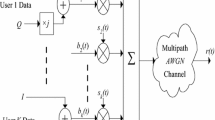Abstract
In this work, we present a new, computationally simple scheme (termed multi-shot approach) to separate and detect multiuser signals in an asynchronous code-division multiple-access (CDMA) communications system. By exploring the structure inherent in the matrix decomposition of properly arranged data, obtained from multi-shot matched filtering, we propose a near-far resistant multiuser detector. The proposed multiuser detector combines the multiple snapshots of matched filter outputs through a matrix filtering and de-biasing processing, revealed from the structure inherent in properly arranged data, prior to the final stage of decision making. Simulation results demonstrate the superior performance of the newly proposed computationally efficient detection scheme in comparison with other existing methods of comparable complexity.
Similar content being viewed by others
References
S. VerdÚ, “Minimum Probability of Error for Asynchronous Gaussian Multiple-Access Channel”, IEEE Trans. Inform. Theory, Vol. IT-32, No.1, pp. 85–96, 1986.
S. Verdu, “Recent Progress in Multiuser Detection”, Advances in Communications and Signal Processing, pp. 27–38, Springer-Verlag, New York.
H. Poor and S. VerdÚ, “Single-User Detectors for Multiuser Channels”, IEEE Trans. Communications, Vol. 36, No.1, pp. 50–60, 1988.
R. Lupas and S. VerdÚ, “Linear Multiuser Detector for Synchronous Code Division Multiple Access Channels”, IEEE Trans. Information Theory, Vol. IT-35, No.1, pp. 123–136, 1989.
M.K. Varanasi and B. Aazhang, “Near-Optimum Detection in Synchronous Code-Division Multiple-Access Systems”, IEEE Trans. Commun., Vol. 39, No.5, pp. 725–736, 1991.
Z. Siveski, Y. Bar-Ness and D.W. Chen, “Error Performance of Synchronous Multiuser Code Division Multiple Access Detector with Multidimensional Adaptive Canceler”, European Trans. Telecommun. Related Technologies, Vol. 5, No.6, pp. 719–724, 1994.
Z. Xie, C.K. Rushforth and R.T. Short, “Multiuser Signal Detection Using Sequential Decoding”, IEEE Trans. Communications, Vol. COM-38, No.5, pp. 578–583, 1990.
Z. Xie, C.K. Rushforth and R.T. Short, “A Family of Suboptimum Detectors for Coherent Multiuser Communications”, IEEE J. Selected Areas Commun., Vol. SAC-8, No.4, pp. 683–690, 1990.
H. Ge and Y. Bar-Ness, “Bayesian Approach of Multiuser Separation and Interference Suppression in CDMA Communications Systems”, Proceedings of the 29th Asilomar Conference on Signals, Systems, and Computers, October 1995.
J. Proakis, Digital Communications, third edition, McGraw-Hill, Inc., NY, 1995.
Z. Siveski, L. Zhong and Y. Bar-Ness, “Adaptive Multiuser Detector for Asynchronous AWGN Channels”, PRIME-94, The Hague, The Netherlands, pp. 416–419, 21–23 September 1994.
Y. Bar-Ness and N. Sezgin, “Adaptive Multiuser Bootstrapped Decorrelating CDMA Detector for One-Shot Asynchronous Unknown Channels”, Proceedings of the International Conference on Acoustics, Speech, and Signal Processing, pp. 1733–1736, Detroit, May 1995.
Author information
Authors and Affiliations
Rights and permissions
About this article
Cite this article
Ge, H., Bar-Ness, Y. Multi-Shot Approach to Multiuser Separation and Interference Suppression in Asynchronous CDMA. Wireless Personal Communications 12, 15–26 (2000). https://doi.org/10.1023/A:1008884925717
Issue Date:
DOI: https://doi.org/10.1023/A:1008884925717




